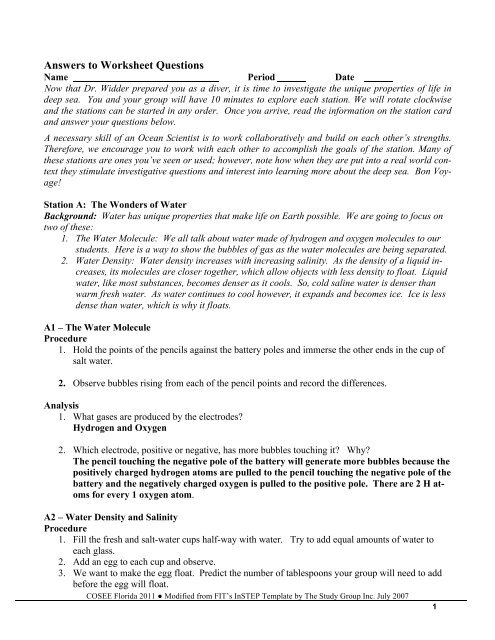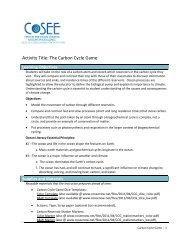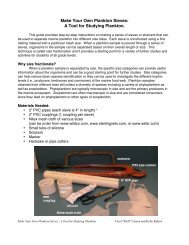Life In the Deep Sea- Worksheets Answer Key - COSEE Florida
Life In the Deep Sea- Worksheets Answer Key - COSEE Florida
Life In the Deep Sea- Worksheets Answer Key - COSEE Florida
You also want an ePaper? Increase the reach of your titles
YUMPU automatically turns print PDFs into web optimized ePapers that Google loves.
<strong>Answer</strong>s to Worksheet QuestionsName Period DateNow that Dr. Widder prepared you as a diver, it is time to investigate <strong>the</strong> unique properties of life indeep sea. You and your group will have 10 minutes to explore each station. We will rotate clockwiseand <strong>the</strong> stations can be started in any order. Once you arrive, read <strong>the</strong> information on <strong>the</strong> station cardand answer your questions below.A necessary skill of an Ocean Scientist is to work collaboratively and build on each o<strong>the</strong>r’s strengths.Therefore, we encourage you to work with each o<strong>the</strong>r to accomplish <strong>the</strong> goals of <strong>the</strong> station. Many of<strong>the</strong>se stations are ones you’ve seen or used; however, note how when <strong>the</strong>y are put into a real world context<strong>the</strong>y stimulate investigative questions and interest into learning more about <strong>the</strong> deep sea. Bon Voyage!Station A: The Wonders of WaterBackground: Water has unique properties that make life on Earth possible. We are going to focus ontwo of <strong>the</strong>se:1. The Water Molecule: We all talk about water made of hydrogen and oxygen molecules to ourstudents. Here is a way to show <strong>the</strong> bubbles of gas as <strong>the</strong> water molecules are being separated.2. Water Density: Water density increases with increasing salinity. As <strong>the</strong> density of a liquid increases,its molecules are closer toge<strong>the</strong>r, which allow objects with less density to float. Liquidwater, like most substances, becomes denser as it cools. So, cold saline water is denser thanwarm fresh water. As water continues to cool however, it expands and becomes ice. Ice is lessdense than water, which is why it floats.A1 – The Water MoleculeProcedure1. Hold <strong>the</strong> points of <strong>the</strong> pencils against <strong>the</strong> battery poles and immerse <strong>the</strong> o<strong>the</strong>r ends in <strong>the</strong> cup ofsalt water.2. Observe bubbles rising from each of <strong>the</strong> pencil points and record <strong>the</strong> differences.Analysis1. What gases are produced by <strong>the</strong> electrodes?Hydrogen and Oxygen2. Which electrode, positive or negative, has more bubbles touching it? Why?The pencil touching <strong>the</strong> negative pole of <strong>the</strong> battery will generate more bubbles because <strong>the</strong>positively charged hydrogen atoms are pulled to <strong>the</strong> pencil touching <strong>the</strong> negative pole of <strong>the</strong>battery and <strong>the</strong> negatively charged oxygen is pulled to <strong>the</strong> positive pole. There are 2 H atomsfor every 1 oxygen atom.A2 – Water Density and SalinityProcedure1. Fill <strong>the</strong> fresh and salt-water cups half-way with water. Try to add equal amounts of water toeach glass.2. Add an egg to each cup and observe.3. We want to make <strong>the</strong> egg float. Predict <strong>the</strong> number of tablespoons your group will need to addbefore <strong>the</strong> egg will float.<strong>COSEE</strong> <strong>Florida</strong> 2011 ● Modified from FIT’s <strong>In</strong>STEP Template by The Study Group <strong>In</strong>c. July 20071
Water as Habitat Workshop 2/26/114. Add salt to <strong>the</strong> salt-water cup and record <strong>the</strong> amount added below. It is ok if you add in slow incrementsto discover <strong>the</strong> approximate amount of salt needed.5. Test your progress by placing 1 egg in each cup and observing.6. Please pour out <strong>the</strong> salt water into <strong>the</strong> bucket, and clean up <strong>the</strong> station area following <strong>the</strong> activity.7. Bonus: use <strong>the</strong> Refractometer to measure <strong>the</strong> salinity of <strong>the</strong> water.Analysis1. Predict <strong>the</strong> number of tablespoons it will take to make <strong>the</strong> egg float? _____ Tsp2. Amount of salt added to make <strong>the</strong> egg float. _About 2_Tsp Salinity? ______3. Why did <strong>the</strong> egg float in <strong>the</strong> salt water but not in <strong>the</strong> fresh water?The salt water is a denser than <strong>the</strong> overall density of <strong>the</strong> egg and <strong>the</strong>refore <strong>the</strong> egg floats.<strong>In</strong> <strong>the</strong> case of <strong>the</strong> fresh water, <strong>the</strong> density of <strong>the</strong> egg is less than <strong>the</strong> water and it sinks.4. Write <strong>the</strong> relationship between salinity and density. As salinity increases…density…As salinity increases, density increases.5. If you were given two water samples, one from <strong>the</strong> deep ocean and one from <strong>the</strong> surface, howmight you be able to tell <strong>the</strong>m apart?The deep ocean sample will be saltier and more dense than <strong>the</strong> surface sample, <strong>the</strong>reforeyou could test by floating an egg in samples of deep ocean and surface water. The eggshould float higher in <strong>the</strong> deep ocean water and lower in <strong>the</strong> surface water.A-3 Water Density and TemperatureProcedure1. Place <strong>the</strong> blue ice cube in <strong>the</strong> cup of water.2. Observe where <strong>the</strong> dye goes. Use <strong>the</strong> <strong>the</strong>rmometer to measure <strong>the</strong> temperature of <strong>the</strong> water in<strong>the</strong> streams of dye compared to <strong>the</strong> temperature of <strong>the</strong> surrounding water.Analysis1. What is <strong>the</strong> temperature of <strong>the</strong> water? _____ of <strong>the</strong> melted blue water? ____2. Where did <strong>the</strong> blue dye go as <strong>the</strong> ice melted?The blue water sinks to <strong>the</strong> bottom of <strong>the</strong> container because <strong>the</strong> colder water is denser.3. How does <strong>the</strong> action of <strong>the</strong> blue water explain how currents could be formed?As cold water sinks, <strong>the</strong> motion of it moving from <strong>the</strong> surface and replacing subsurface watercreates deep water currents.ConclusionsThe zone in which temperature changes rapidly with depth is called a <strong>the</strong>rmocline, <strong>the</strong> zone in whichsalinity changes rapidly with depth is called a halocline and <strong>the</strong> zone in which density changes rapidlywith depth is called a pycnocline. These “clines” (from <strong>the</strong> Greek word meaning “to lean” like an incline)have a profound influence on where different animals live in <strong>the</strong> ocean.1. Which of <strong>the</strong> previous experiments demonstrates how <strong>the</strong>se clines can be formed? Explain.2 <strong>COSEE</strong> <strong>Florida</strong>
Lesson Plan: Animal Adaptations to <strong>Life</strong> in <strong>the</strong> <strong>Deep</strong>-<strong>Sea</strong>Station A-2 and A-3 demonstrate how a <strong>the</strong>rmocline, pycnocline and halocline can beformed. Station A-2 shows us that <strong>the</strong> saltier <strong>the</strong> water, <strong>the</strong> more dense <strong>the</strong> water will become.The ocean is influenced by a variety of waters inputs and outputs that influence <strong>the</strong>salinity, like evaporation at <strong>the</strong> equator or fresh water inputs. These waters <strong>the</strong>n stratifyinto a halocline. Station A-3 looks at <strong>the</strong> effect of <strong>the</strong> temperature on <strong>the</strong> density of <strong>the</strong> water.The colder <strong>the</strong> water, <strong>the</strong> more dense it is and this stratifies <strong>the</strong> ocean (with exceptionto <strong>the</strong> polar regions) with a distinct <strong>the</strong>rmocline of warmer, less dense waters at <strong>the</strong> surface,and cooler, more dense waters at depth.2. Look at <strong>the</strong> graphs of a <strong>the</strong>rmocline, halocline and pycnocline below. What is life like in <strong>the</strong>deep sea (below 1000 or 1500 m) in terms of temperature, salinity and density?Very cold, moderately saline and dense water.3. How do you think <strong>the</strong>se different properties might influence where different animals live?Some organisms are better adapted for warmer water and live shallower, while some haveadapted for <strong>the</strong> cold water environment and live deeper. Some are better adapted for saltierwater and some have higher density tissues and so <strong>the</strong>y live in deeper waters. Manyanimals maintain <strong>the</strong>ir depth in <strong>the</strong> water not by swimming but by <strong>the</strong> density of <strong>the</strong>ir bodiesso like <strong>the</strong> eggs <strong>the</strong>y will float at <strong>the</strong> depth that matches <strong>the</strong>ir density.Station B: Animal Adaptations to <strong>Life</strong> in <strong>the</strong> <strong>Deep</strong> <strong>Sea</strong> – Using bioluminescence to surviveBackground: Many animals spend most of <strong>the</strong>ir lives in near darkness and use bioluminescence to help<strong>the</strong>m do all <strong>the</strong> things <strong>the</strong>y need to do to survive: find food, attract mates and avoid being eaten. <strong>In</strong> factmost of <strong>the</strong> animals living in <strong>the</strong> open ocean – out away from shore – are bioluminescent.<strong>COSEE</strong> <strong>Florida</strong> 3
Water as Habitat Workshop 2/26/11Advantages of bioluminescence vary. Many fish, squid and shrimp use <strong>the</strong>ir bioluminescence forcamouflage with a trick called counterillumination. Dim blue light filters down through <strong>the</strong> depths in<strong>the</strong> midwater or mesopelagic zone (200-1000 m). At <strong>the</strong>se depths predators can locate prey by searchingfor <strong>the</strong> silhouettes of <strong>the</strong> animals swimming above <strong>the</strong>m. To camouflage <strong>the</strong>mselves, organismshave photophores (light organs) located on <strong>the</strong>ir bellies or ventral sides of <strong>the</strong>ir bodies. These photophoresare used to produce light that matches <strong>the</strong> color and intensity of light coming from above. Thismakes <strong>the</strong> animal almost invisible to <strong>the</strong> predators below <strong>the</strong>m. Animals can even adjust <strong>the</strong> light from<strong>the</strong>ir belly lights to match <strong>the</strong> light fluctuations from above.ProcedureThere are 10 deep-sea specimens for you to observe at this station. <strong>In</strong>vestigate and explore <strong>the</strong> adaptations<strong>the</strong>se organisms have to survive life in <strong>the</strong> deep sea. Then choose four of <strong>the</strong> organisms to focuson and answer <strong>the</strong> following questions.1. Where are <strong>the</strong> bioluminescent organs located on <strong>the</strong> organism and how does <strong>the</strong> production of lightin <strong>the</strong>se specific areas benefit <strong>the</strong> organism? On <strong>the</strong> ventral side (belly), sides of body and around<strong>the</strong> head. <strong>Deep</strong>-sea organisms use bioluminescence to hide, find food and find a mate. For example,lateral photophores are often used to counterilluminate <strong>the</strong> light above to help <strong>the</strong> organismscamouflage in <strong>the</strong> open ocean.2. What o<strong>the</strong>r adaptations enable this organism to reside in <strong>the</strong> deeper depths of <strong>the</strong> ocean? Dentition,Color, Body shape, Eyes.3. If you have time, sketch <strong>the</strong> organism and color in <strong>the</strong> photophores with highlighter.Analysis See Animal Adaptations Cards1. Organism 1 ____________________a. Bioluminescent lightb. O<strong>the</strong>r Adaptations2. Organism 2____________________a. Bioluminescent lightb. O<strong>the</strong>r Adaptations3. Organism 3____________________a. Bioluminescent lightb. O<strong>the</strong>r Adaptations4. Organism 4____________________a. Bioluminescent lightb. O<strong>the</strong>r Adaptations4 <strong>COSEE</strong> <strong>Florida</strong>
Lesson Plan: Animal Adaptations to <strong>Life</strong> in <strong>the</strong> <strong>Deep</strong>-<strong>Sea</strong>Conclusions1. Name 3 ways animals use bioluminescence to survive.Finding Food, Defense, Finding mates2. Why do you think <strong>the</strong> majority of bioluminescence in <strong>the</strong> ocean is blue in color?Blue light travels fur<strong>the</strong>r through seawater than any o<strong>the</strong>r color so it is <strong>the</strong> best color forcommunicating over long distancesStation C: Changes with Depth – PressureBackground: The weight of <strong>the</strong> Earth’s atmosphere at <strong>the</strong> surface of <strong>the</strong> ocean is equal to 1 atmosphere,1 bar, or 14.7 pounds per square inch (psi). You are exposed to that amount of pressure every day.Water is much denser than air, and if you dive into <strong>the</strong> ocean you will experience an increase in pressureas you dive deeper. The deeper you go in <strong>the</strong> ocean, <strong>the</strong> greater <strong>the</strong> amount of water you havepressing in on you. The greatest impact is on animals with gas-filled spaces in <strong>the</strong>ir bodies – such asear canals and fish swim bladders.C1 – Water Pressure Demonstration TubeProcedure1. Using <strong>the</strong> beaker or pitcher, fill <strong>the</strong> cylinder with water to approximately 1 cm from <strong>the</strong> top.2. Using three hands, remove <strong>the</strong> blue corks from <strong>the</strong> demonstration cylinder at <strong>the</strong> same time.3. Observe <strong>the</strong> spouts of water.4. Repeat if necessary.Analysis1. What is <strong>the</strong> relationship between <strong>the</strong> distance of <strong>the</strong> holes from <strong>the</strong> top of <strong>the</strong> cylinder and <strong>the</strong> streamlength:The weight of water is heavy. The water on <strong>the</strong> bottom of <strong>the</strong> cylinder has more heavy water piled ontop which influences <strong>the</strong> water pressure. With more weight and water pressure, <strong>the</strong> water from <strong>the</strong> bottomspout is pushed with more force and is <strong>the</strong> strongest and fur<strong>the</strong>st jet.. Students should be able toexplain that <strong>the</strong> weight of <strong>the</strong> water is greater at <strong>the</strong> 3 rd hole and shows <strong>the</strong> increase in pressure withdepth – see diagram below.WikiConclusions –Water is heavy, much heavier than air. The weight of <strong>the</strong> Earth’s atmosphere at <strong>the</strong> surface of <strong>the</strong> oceanis equal to 1 atmosphere or 14.7 pounds per square inch (psi). If you dive into <strong>the</strong> ocean you feel <strong>the</strong>pressure build up very quickly because water is so heavy compared to air. At just 10 m <strong>the</strong> pressuredoubles to 2 atmospheres or 29.4 psi. If you dive deeper <strong>the</strong> pressure increases. For every 10 m thatyou descend you add ano<strong>the</strong>r 14.7 psi (see below).<strong>COSEE</strong> <strong>Florida</strong> 5
Water as Habitat Workshop 2/26/11Pressure (psi)00 100 200 300 400 500 600 700 800100Depth (m)2003004005006001. Use <strong>the</strong> graph above to determine how much pressure a fish would feel that is living at 500 m? 764.4psiA B E.Widder2. Note <strong>the</strong> differences in <strong>the</strong> size of <strong>the</strong> swim bladder in <strong>the</strong>se two fish, A and B. They are <strong>the</strong> samespecies and size of fish, however fish B has a noticeable increase of gasses in <strong>the</strong> swim bladder. Whichfish would be swimming higher in <strong>the</strong> water column?Fish B would be higher in <strong>the</strong> water column due to <strong>the</strong> increase in gasses and buoyancy. Manyfishes regulate <strong>the</strong>ir buoyancy through <strong>the</strong> swim bladder, to remain neutrally buoyant. Gassesconsist primarily of nitrogen, oxygen, and carbon dioxide. There are 2 types of swim bladder:open and closed. The open bladder is connected to <strong>the</strong> esophagus and air is gulped and stored in<strong>the</strong> swim bladder. The closed type of swim bladder is not connected to <strong>the</strong> esophagus and insteadregulates <strong>the</strong> gasses in <strong>the</strong> swim bladder through gas exchange in <strong>the</strong> bloodstream.Station D: Changes with Depth – What is Light?Emitted light results from changes that occur in atoms when <strong>the</strong>y absorb energy. Different types of lightare distinguished by <strong>the</strong>ir different sources of energy. The two main forms of light are incandescenceor hot light and luminescence or cold light.6 <strong>COSEE</strong> <strong>Florida</strong>
Lesson Plan: Animal Adaptations to <strong>Life</strong> in <strong>the</strong> <strong>Deep</strong>-<strong>Sea</strong><strong>In</strong> incandescence <strong>the</strong> energy to produce <strong>the</strong> light comes from heat so <strong>the</strong>se sources generate both heatand light. Examples include <strong>the</strong> sun, a candle flame and an incandescent light bulb.<strong>In</strong> luminescence <strong>the</strong> energy to produce <strong>the</strong> light is produced by some means o<strong>the</strong>r than heating. Fourexamples o f luminescence are:• Fluorescence – The energy comes from light. Wavelengths of light are absorbed and <strong>the</strong> substanceimmediately re-emits <strong>the</strong> light at a lower intensity. The re-emitted light stops when youremove <strong>the</strong> light source. “Black Light” posters are fluorescent.• Phosphorescence – The energy comes from light. Wavelengths of light are absorbed and <strong>the</strong>substance slowly re-emits <strong>the</strong> light at a lower intensity. The re-emitted light does not stopwhen you remove <strong>the</strong> light source. It may continue re-emitting light for a long time. Glow-<strong>In</strong>-The-Dark paint and toys are phosphorescent.• Chemiluminescence – The energy comes from a chemical reaction and is generated by <strong>the</strong> releaseof energy created from <strong>the</strong> chemicals combining.• Bioluminescence – The energy comes from a chemical reaction and is a form of chemiluminescencecreated by living organisms. Fireflies and lantern fish bioluminese.Procedure/AnalysisD-1 <strong>In</strong>candescence and LuminescenceRead <strong>the</strong> background information and <strong>the</strong>n look at <strong>the</strong> real world examples of light. Dr. Widder mayalso provide insight as well.Record <strong>the</strong> following observations:<strong>In</strong>candescence Fluorescence Phosphorescence Chemiluminescence BioluminescenceHot or Hot Cold Cold Cold ColdCold?Energy Electricity Light Light Chemical ChemicalSourceColors? All Colors All Colors All Colors All Colors All Colorsmostlyblue andgreenD-2 Fluorescence and Phosphorescence1. Use <strong>the</strong> UV flashlight to shine on <strong>the</strong> fluorescent material (Fluorescent highlighter and clay).Turn <strong>the</strong> light off.Did <strong>the</strong> fluorescent material emit light after <strong>the</strong> flashlight was turned off?No, Fluorescence requires light to be emitted before it can be reemitted in <strong>the</strong> form of fluorescence.2. Use <strong>the</strong> UV flashlight to shine on <strong>the</strong> phosphorescent material (Phosphorescent putty in petridishes). Turn <strong>the</strong> light off.Did <strong>the</strong> phosphorescent material emit light after <strong>the</strong> flashlight was turned off?Yes, Phosphorescence will be emitted at a lower energy in <strong>the</strong> form of fluorescence, even after<strong>the</strong> radiant light energy has been removed.<strong>COSEE</strong> <strong>Florida</strong> 7
Water as Habitat Workshop 2/26/113. Now try <strong>the</strong> flashlight with <strong>the</strong> red light.Record <strong>the</strong> difference in luminescence emitted using <strong>the</strong> red light and UV light.The UV light produced more reemitted phosphorescence than <strong>the</strong> red light.4. After you removed <strong>the</strong> light source from <strong>the</strong> putty, which light produced <strong>the</strong> larger amount ofluminescence in <strong>the</strong> putty? Explain.The UV light is a higher energy, shorter wavelength. The red light is a lower energy,longer wavelength. Therefore <strong>the</strong>re is a higher amount of energy introduced by <strong>the</strong> UVlight, and subsequently a larger amount of light reemitted by <strong>the</strong> phosphorescent material.D-3 Chemiluminescence – Light SticksObserve <strong>the</strong> two light sticks: one is in hot water and one in cold water.1. After an hour at <strong>the</strong>se different temperatures- If you allow each light stick to come back to roomtemperature, do you think <strong>the</strong>y will emit <strong>the</strong> same amount of light or will one be brighter thanano<strong>the</strong>r?One brighter than <strong>the</strong> o<strong>the</strong>r. After an hour (or longer if a high quality light stick) <strong>the</strong> onein colder water will be brighter than <strong>the</strong> light stick in <strong>the</strong> hot water.2. If <strong>the</strong> latter, which one will be brighter and why?The one in hot water because <strong>the</strong> chemicals are moving slower and bumping into eacho<strong>the</strong>r less often. If you allow <strong>the</strong> light sticks to come to room temperature and <strong>the</strong>n compare<strong>the</strong>m you will find that <strong>the</strong> light stick that was in <strong>the</strong> cold is <strong>the</strong> brighter one. This isbecause while it was cold it was using up its light producing chemicals more slowly than <strong>the</strong>light stick in <strong>the</strong> hot water. So now <strong>the</strong> difference in brightness is due to different concentrationsof <strong>the</strong> reacting chemicals, ra<strong>the</strong>r than to different speeds.D-4 BioluminescenceGently stimulate <strong>the</strong> dinoflagellates.1. What color is <strong>the</strong> light emitted and what happened to <strong>the</strong> flashes of light over time?Blue flash of light. Note that <strong>the</strong>y flash when disturbed and each flash is dimmer than <strong>the</strong>last because just as with <strong>the</strong> light sticks <strong>the</strong> chemicals are used up. Given time and sunlight,so that <strong>the</strong>y can photosyn<strong>the</strong>size, <strong>the</strong>se dinoflagellates can produce new chemicals.Students should realize that animals need to produce cold light to keep from burning up.2. Predict why this light may be beneficial for <strong>the</strong> dinoflagellate?And many animals use bioluminescence to avoid being eaten. Some can release <strong>the</strong>irbioluminescent chemicals into <strong>the</strong> water to distract or temporarily blind a predator.O<strong>the</strong>rs use <strong>the</strong>ir bioluminescence once <strong>the</strong>y are caught by a predator to attract <strong>the</strong>attention of a larger predator that will attack <strong>the</strong>ir attack and give <strong>the</strong>m a chance toescape. This display is called a burglar alarm and is <strong>the</strong> most commonly accepted reasondinoflagellates produce light.Station E: Changes with Depth – Light in <strong>the</strong> Ocean8 <strong>COSEE</strong> <strong>Florida</strong>
Lesson Plan: Animal Adaptations to <strong>Life</strong> in <strong>the</strong> <strong>Deep</strong>-<strong>Sea</strong>Background: Visible light can be emitted, scattered and absorbed and <strong>the</strong>se properties play key rolesin how light is transferred through ocean depths. The amount of sunlight in oceanic waters decreaseswith depth, and <strong>the</strong> color changes as <strong>the</strong> wavelengths of light become scattered and absorbed. Most of<strong>the</strong> visible light is absorbed in <strong>the</strong> top 10 meters of <strong>the</strong> surface with very little visible light penetratingbelow 150 meters depth. Wavelengths of light change are absorbed and scattered with depth as well.The longer wavelengths like red light are absorbed first where as <strong>the</strong> shorter wavelengths penetratedeeper.The absence or presence of light defines where organisms live in <strong>the</strong> water column. Visible wavelengthsof light from <strong>the</strong> sun allow photosyn<strong>the</strong>sis to occur in plants inhabiting <strong>the</strong> surface layers of <strong>the</strong>ocean. Below <strong>the</strong>se surface layers (between 100-1000 m) is a dimly lit area that does not support photosyn<strong>the</strong>sisbut animals live <strong>the</strong>re. Sunlight is absent below 1000m.Station E-1 Light BottlesProcedure1. Turn out lights and shine <strong>the</strong> flashlight into <strong>the</strong> top of each bottle. If <strong>the</strong> flashlight is waterproof,push <strong>the</strong> light against <strong>the</strong> surface of <strong>the</strong> water.2. Record how <strong>the</strong> light looks as it shines through each bottle. Pay attention to <strong>the</strong> colors of lightyou see and <strong>the</strong> relative depths where <strong>the</strong>y dissipate.BottleNumberTreatmentObservations withWhite LightObservations with BlueLight stickObservations withRed Light stick1 Water only Light goes through water.VisibleVisible2 Water + Coffeecreamer3 Water + BluedyeLight scatteredthroughout water andout of bottle.Light goes through water.Not visible, but <strong>the</strong> bluelight is scattered throughout<strong>the</strong> water.VisibleRed light scatteredbut diminished intensity.Diminished light anda different color.4 Water + Coffeecreamer +Blue DyeLight scatters throughout<strong>the</strong> water.Not visible, but <strong>the</strong> bluelight is scattered throughout<strong>the</strong> water.3. Activate blue and red light sticks4. Lower <strong>the</strong> blue light stick into each bottle, one after <strong>the</strong> o<strong>the</strong>r5. Observe and record <strong>the</strong> light you see in each bottle above6. Lower <strong>the</strong> red light stick into each bottle, one after <strong>the</strong> o<strong>the</strong>r7. Observe and record <strong>the</strong> light you see in each bottle above.Very little light observed.Light stickdisappears.<strong>COSEE</strong> <strong>Florida</strong> 9
Water as Habitat Workshop 2/26/11Analysis1. Did <strong>the</strong> light decrease in intensity or retain <strong>the</strong> same intensity as it passed through <strong>the</strong> water? Explain.Comparing <strong>the</strong> 1 st and 2 nd bottles demonstrates that you only see light that is scattered towardyour eye. (Note that visible lasers seen in Hollywood movies like Oceans 12 are a myth. You can’tsee <strong>the</strong> laser unless <strong>the</strong>re are particles in <strong>the</strong> air or <strong>the</strong> water to reflect <strong>the</strong> light toward your eye.)Comparing <strong>the</strong> 1 st and 2 nd bottles with <strong>the</strong> 3 rd and 4 th bottles shows what happens when light is absorbed– <strong>the</strong> intensity of light diminishes. Note that blue dye appears blue because it absorbs allcolors except blue. Similarly seawater appears blue because it scatters blue light.The 4 th bottle demonstrates what happens over very long distances in <strong>the</strong> ocean – light is bothscattered and absorbed. The more particles <strong>the</strong>re are in <strong>the</strong> water - as occurs in coastal waterswhere sediment runs off <strong>the</strong> land – <strong>the</strong> more <strong>the</strong> light is redirected and <strong>the</strong> more opportunities ithas to be absorbed, <strong>the</strong>refore <strong>the</strong> light doesn’t penetrate as far as it does in very clear water awayfrom shore.<strong>In</strong> clear ocean water, visible light decreases approximately 10-fold for every 75 m that you descend.This means that at 75 m <strong>the</strong> light is 10% as bright as it was at <strong>the</strong> surface; and at just twice that depth,150 m, it is ano<strong>the</strong>r 10-fold dimmer, or 1% of surface light. Below this depth <strong>the</strong>re is insufficient lightfor photosyn<strong>the</strong>sis, but <strong>the</strong>re is still plenty of light for seeing. This is because eyes are useful over an astonishingrange of intensities. It is believed that <strong>the</strong> very sensitive eyes of some deep-sea fish can stilldetect sunlight at 1000 m.To calculate <strong>the</strong> 10% decrease in light with each 75 m of increasing depth you simply multiply <strong>the</strong> lightby 0.1, which is <strong>the</strong> same as 10%Depth (m)Percentage of surface light0 10075 10150 1225 0.1300 0.01375 0.001450 0.000110 <strong>COSEE</strong> <strong>Florida</strong>
Lesson Plan: Animal Adaptations to <strong>Life</strong> in <strong>the</strong> <strong>Deep</strong>-<strong>Sea</strong>2. Plot <strong>the</strong>se data on <strong>the</strong> graph below:PercentageofSurfaceLightDepth(m)0501001502002503003504004500 20 40 60 80 100E-2 – Challenges of <strong>the</strong> <strong>Deep</strong>Procedure: View <strong>the</strong> video clip from: Challenges of <strong>the</strong> <strong>Deep</strong> – Survival at Extreme Depths.Analysis1. List <strong>the</strong> colors from <strong>the</strong> color chart attached to <strong>the</strong> ROV, in <strong>the</strong> order <strong>the</strong>y disappeared during <strong>the</strong>decent. Red, Green and Yellow almost simultaneously, BlueConclusions1. What factors affected <strong>the</strong> light transmission in <strong>the</strong> bottle?The amount of particulate or creamer in <strong>the</strong> water scattering light. The color of <strong>the</strong> waterthat influences <strong>the</strong> visible light spectrum2. Why is <strong>the</strong> red wavelength of light absorbed quickly in <strong>the</strong> water, and blue light penetrates fur<strong>the</strong>r?Wavelengths of light are scattered at <strong>the</strong> ocean surface and absorbed as <strong>the</strong> water becomesdeeper. The longer wavelengths with lower energy are red and orange. These wavelengthsare quickly absorbed, leaving only <strong>the</strong> shorter, higher energy wavelengths of light available.The shorter wavelengths, violet and blue, are higher in energy and penetrate fur<strong>the</strong>rinto <strong>the</strong> depths of <strong>the</strong> ocean. This blue light that remains is why <strong>the</strong> ocean looks blue.3. Figure 2 below is a graph that shows light penetration in <strong>the</strong> open ocean vs. coastal waters.What are 2 factors that would affect light penetration in both <strong>the</strong> coastal waters and open ocean?<strong>COSEE</strong> <strong>Florida</strong> 11
Water as Habitat Workshop 2/26/11Explain to students that although when plotted on a graph like this it looks like <strong>the</strong>re is nolight below 150 m that, in fact, <strong>the</strong>re is enough light for animals to see each o<strong>the</strong>r down toas deep as 1000 m.Figure 2. Light attenuation in open ocean vs. coastal waters. NOAA12 <strong>COSEE</strong> <strong>Florida</strong>
Critical Thinking Questions (2-3)1. How does both produced light, in <strong>the</strong> form of bioluminescence, and ambient light play a role inpredator – prey relationships in <strong>the</strong> mid-water and deep sea?Bioluminescence is utilized by predators to find prey by means of a lure, or even emitted like aflashlight to help search for prey. Fortunately for <strong>the</strong> prey, bioluminescence is also used incounterillumination, to reduce <strong>the</strong>ir silhouette, and alleviate <strong>the</strong> chance of predators seeing<strong>the</strong>m from below. This is much like countershading used by organisms nearer surface waters(lighter ventral coloration/darker dorsal coloration). Bioluminescence can also be used byprey as a burglar alarm, and also emitted as a blinding mechanism or to get <strong>the</strong> predator’s attentionto focus on <strong>the</strong> bioluminescent chemicals in <strong>the</strong> water, while <strong>the</strong> prey can move tosafety undetected. The small amount of light in <strong>the</strong> mesopelagic zone may not be visible tohumans, however many of <strong>the</strong> organisms in this region of <strong>the</strong> ocean have adapted to see thisminimal light. Predators depend on this light to feed, and prey uses <strong>the</strong> light as well to illuminatepredators. As <strong>the</strong> light diminishes in <strong>the</strong> evening, vertical migration is triggered and animalsmove up to <strong>the</strong> surface waters to feed in <strong>the</strong> dark waters. Even <strong>the</strong> small changes in ambientlight in <strong>the</strong>se deeper waters changes behavior and predator-prey strategies.2. Although a great distance divides <strong>the</strong> surface waters from <strong>the</strong> deep sea; <strong>the</strong> productivity of <strong>the</strong> midwaterand deep sea is largely dependent upon energy produced in <strong>the</strong> surface waters. Describe 3ways <strong>the</strong> surface waters provide energy to <strong>the</strong> mid-water and deep sea.Cold water sinking due to increased density brings a great deal of nutrients from <strong>the</strong> surfacewaters. Primary productivity in <strong>the</strong> photic zone moves through <strong>the</strong> food web to <strong>the</strong> deep-seaorganisms. (Many of <strong>the</strong> larval stages of deep-sea organisms actually inhabit upper layers of<strong>the</strong> ocean until <strong>the</strong>y move into juvenile stages and descend)Marine Snow is a primary source of food for many deep sea and benthic organisms- small bitsof organic matter descend from surface waters. Vertical migration occurs when large massesof organisms move up in <strong>the</strong> water column to feed on abundant plankton in <strong>the</strong> surface waters.<strong>Deep</strong>-sea organisms ascend as well to feed.3. Imagine you are diving down to 2000 meters deep and looking out your submersible window. Whatchanges would you observe as you submerged and at what depths would you expect to find <strong>the</strong>sechanges occurring?Light will quickly diminish as we dive. Depending upon where we dive and <strong>the</strong> turbidity of<strong>the</strong> water, only 1% of <strong>the</strong> surface light will be available around 150 meters. Below that depthto 1000 meters, it will seem dark to our eyes and we will use <strong>the</strong> sub lights to navigate down.Organisms living in <strong>the</strong>se mesopelagic zones are able to utilize <strong>the</strong> minimal rays of light to see.Below 1000 m, <strong>the</strong> waters outside <strong>the</strong> sub seem pitch dark with <strong>the</strong> lights on, yet fantasticallyilluminated by surrounding bioluminescence when <strong>the</strong> sub lights are turned off. O<strong>the</strong>r observationswill depend upon <strong>the</strong> depth of <strong>the</strong> <strong>the</strong>rmocline. The bright upper waters are warm andas <strong>the</strong> waters get dark, <strong>the</strong>y will also get cold. We are protected within <strong>the</strong> engineering of <strong>the</strong>sub that is bearing <strong>the</strong> increasing pressure with depth.<strong>COSEE</strong> <strong>Florida</strong> 2011 ● Modified from FIT’s <strong>In</strong>STEP Template by The Study Group <strong>In</strong>c. July 200713








